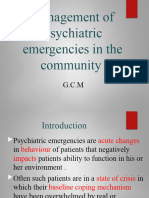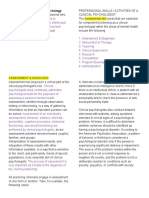BPCC 111
BPCC 111
Uploaded by
prathamjiraineCopyright:
Available Formats
BPCC 111
BPCC 111
Uploaded by
prathamjiraineCopyright
Available Formats
Share this document
Did you find this document useful?
Is this content inappropriate?
Copyright:
Available Formats
BPCC 111
BPCC 111
Uploaded by
prathamjiraineCopyright:
Available Formats
BPCC 111
Q3) Explain the clinical picture of suicide.
The clinical picture of suicide encompasses a complex interplay of psychological, social, and
biological factors. It often involves a sense of hopelessness, intense emotional distress, and a
perceived inability to cope with life's challenges. Risk factors may include mental illness,
substance abuse, past trauma, and a lack of social support. Warning signs such as sudden
changes in behavior, withdrawal from activities, and expressing suicidal thoughts or intentions
are crucial indicators. Understanding these elements is vital for early intervention and
prevention efforts, aiming to provide support, therapy, and access to mental health resources to
those at risk..
Q4) What is autism spectrum disorder?
Autism Spectrum Disorder is a neurodevelopmental condition characterized by challenges in
social interaction, communication, and repetitive behaviors. It manifests differently in each
individual, hence the term "spectrum." Symptoms typically emerge in early childhood and can
range from mild to severe. Common traits include difficulties in understanding social cues,
repetitive movements or speech patterns, and intense focus on specific interests. While the
exact cause remains unclear, genetic and environmental factors likely contribute. Early
diagnosis and interventions, such as behavioral therapy and educational support, can help
individuals with ASD navigate daily life and reach their full potential.
Q4) Describe the different elements of clinical assessment.
Clinical assessment involves a multidimensional approach to understanding an individual's
mental health. It encompasses gathering historical information through interviews, observing
behavior, and utilizing standardized tests to evaluate specific symptoms or functioning levels.
Collateral information from sources like family members adds depth. Assessing risk factors such
as suicidality or substance abuse is crucial. The process aims to create a comprehensive
understanding of the individual's strengths, challenges, and treatment needs, guiding the
formulation of an effective intervention plan tailored to their unique circumstances.
Q4) Describe the causal factor of attention deficits hyperactivity disorder (ADHD).
Attention Deficit Hyperactivity Disorder (ADHD) is a complex neurodevelopmental disorder that
affects both children and adults. While the exact causal factors of ADHD are still not fully
understood, there are several factors that have been identified as potential contributors. One of the
main factors is believed to be genetics, as studies have shown that ADHD tends to run in families.
Additionally, certain environmental factors may also play a role in the development of ADHD, such as
exposure to toxins during pregnancy or early childhood. Furthermore, imbalances in brain chemicals
and structures involved in attention and impulse control have also been linked to ADHD. Overall, it is
likely that a combination of genetic and environmental factors contribute to the development of this
disorder.
Q4) What is cognitive behavioral therapy (CBT).
Cognitive behavioral therapy (CBT) is a powerful and innovative approach to psychotherapy that
aims to address the connections between our thoughts, emotions, and behaviors. It is a collaborative
and goal-oriented therapy that helps individuals identify and challenge their negative thinking
patterns and replace them with more positive and realistic thoughts. By doing so, CBT helps
individuals change their behavior and improve their emotional well-being. This therapy is based on
the belief that our thoughts influence our feelings, which in turn affect our actions. With CBT,
individuals learn to recognize and reframe their negative thoughts, leading to healthier and more
adaptive behaviors
Q4) What are the five types of specific phobias defined by DSM-5?
fear is a formidable force. It can grip us, paralyze us, and dictate our actions. Within the intricate web
of fears, specific phobias hold a unique place. Defined by the DSM-5, these phobias are categorized
into five distinct types.
The first type is animal phobias, where individuals experience an overwhelming fear of specific
animals such as spiders, snakes, or dogs.
The second type is natural environment phobias, which encompasses fears related to natural
elements like heights, storms, or water.
The third type is blood-injection-injury phobias, where individuals fear blood, needles, or medical
procedures.
The fourth type is situational phobias, involving fears of specific situations like flying, driving, or
enclosed spaces.
You might also like
- Hymn Altered Harmonizations Descants Last VerseDocument154 pagesHymn Altered Harmonizations Descants Last VerseAnonymous pMgjvHvC4119% (128)
- Mathematics SbaDocument6 pagesMathematics Sbajaylicia beckett83% (6)
- Script Submission ReleaseDocument3 pagesScript Submission ReleaseJust MeNo ratings yet
- E-Learning Notes (Edited)Document135 pagesE-Learning Notes (Edited)mugumeaugustine66No ratings yet
- CH-5-Part IDocument11 pagesCH-5-Part IpratishthanathwaniNo ratings yet
- Lesson 2 The Skills Activities of A Clinical PsychologistDocument6 pagesLesson 2 The Skills Activities of A Clinical PsychologistReg RoseteNo ratings yet
- Chapter 4 NotesDocument13 pagesChapter 4 NotesDlorrie879No ratings yet
- Psychopathology: Histrionic Personality Disorder I. DefinitionDocument6 pagesPsychopathology: Histrionic Personality Disorder I. DefinitionJustine DegamoNo ratings yet
- Crisis Counselling - Caring People With Mental DistubancesDocument6 pagesCrisis Counselling - Caring People With Mental DistubancesVictor JamesNo ratings yet
- Mental Health Lecture Notes - Miss. Kumbalay RN Yr2Document53 pagesMental Health Lecture Notes - Miss. Kumbalay RN Yr2Abass MiamiNo ratings yet
- Lesson 2 The Skills Activities of A Clinical PsychologistDocument6 pagesLesson 2 The Skills Activities of A Clinical Psychologistjericho anchetaNo ratings yet
- Personality Disorders and Crime (Lecture Notes)Document8 pagesPersonality Disorders and Crime (Lecture Notes)Nadia MuhammadNo ratings yet
- Clinical AssignmentDocument8 pagesClinical Assignmentmakanjuoladolapo02No ratings yet
- Assignment 1Document6 pagesAssignment 1benNo ratings yet
- PsychopathologyDocument24 pagesPsychopathologyamulya anandNo ratings yet
- Hi.. Pathology.. Question #1-WPS OfficeDocument7 pagesHi.. Pathology.. Question #1-WPS OfficeArsalan AkhtarNo ratings yet
- 4.discuss What Emotional and Behavioral Disorder and Its Classification?Document5 pages4.discuss What Emotional and Behavioral Disorder and Its Classification?birhane2kaleabNo ratings yet
- ACTIVITY RLEDocument6 pagesACTIVITY RLEAlfonz SupernovaNo ratings yet
- Paper 3 Unit 6 CHILD PSYCHIATRYDocument28 pagesPaper 3 Unit 6 CHILD PSYCHIATRYyoshita.chikkyNo ratings yet
- PSYC-The Psychopathology of Everyday Life-NotesDocument155 pagesPSYC-The Psychopathology of Everyday Life-NotesHarrison MolloyNo ratings yet
- Human Behavior and VictimologyDocument66 pagesHuman Behavior and VictimologyCASTILLO MILDRED F.No ratings yet
- 04 IntroductionDocument33 pages04 IntroductionMayankNo ratings yet
- Psychosocial IntegrityDocument3 pagesPsychosocial IntegrityRojannie SalenNo ratings yet
- Abnormal Psychology - Past and PresentDocument19 pagesAbnormal Psychology - Past and PresentRizwana MBTNo ratings yet
- Grade XII - Psychology - Psychological DisordersDocument22 pagesGrade XII - Psychology - Psychological Disordersamogh69pahurkarNo ratings yet
- Ocd RehabilitationDocument3 pagesOcd Rehabilitationsantraneha19No ratings yet
- Applied Unit 3Document19 pagesApplied Unit 3viji sathishNo ratings yet
- Lesson 1-3Document35 pagesLesson 1-3Sophia DGNo ratings yet
- PsychopathologyDocument24 pagesPsychopathologySwarn Raj SahukariNo ratings yet
- GROUP 3 Mental Health Final PresantationDocument23 pagesGROUP 3 Mental Health Final PresantationtonewainainaNo ratings yet
- Chapter 5Document42 pagesChapter 5peachypeachyNo ratings yet
- Comparative Research EssayDocument9 pagesComparative Research EssayJohnNo ratings yet
- Psychology Investigatory ProjectDocument18 pagesPsychology Investigatory Projectmaitreya.medhekarNo ratings yet
- Assignment 3Document6 pagesAssignment 3Raja MubeenNo ratings yet
- Chapter 1Document6 pagesChapter 1pairednursingNo ratings yet
- Psyc Essay Final 010420Document2 pagesPsyc Essay Final 010420Ali HajassdolahNo ratings yet
- Abnormal BehaviorDocument4 pagesAbnormal Behaviormini0001974No ratings yet
- Mental DisorderDocument5 pagesMental DisorderHijaz Turoha100% (1)
- Psychotherapy For Treating Anxiety DisordersDocument11 pagesPsychotherapy For Treating Anxiety DisordersShaista ArshadNo ratings yet
- Nature and Application of PhyscologyDocument9 pagesNature and Application of Physcologyai5162139No ratings yet
- Lecture 13Document13 pagesLecture 13evrabonfaceNo ratings yet
- Psycho PathologyDocument2 pagesPsycho PathologyMelton Olivas DecanoNo ratings yet
- An Introduction To Psychopathology: Concepts, Paradigms and StigmaDocument13 pagesAn Introduction To Psychopathology: Concepts, Paradigms and StigmaVictoria GrayNo ratings yet
- Assignment 111-2Document3 pagesAssignment 111-2irummnadeemNo ratings yet
- Intro To UpdDocument24 pagesIntro To Updkhushi chopra 0050No ratings yet
- Short Notes On Abnormal Psychology - 113109Document23 pagesShort Notes On Abnormal Psychology - 113109kizzdonielNo ratings yet
- 1.MANAGEMENT OF PSCHIATRIC EMERGENCIESpower PointDocument33 pages1.MANAGEMENT OF PSCHIATRIC EMERGENCIESpower PointJoseph MuzabulaNo ratings yet
- Mental Health TheoriesDocument6 pagesMental Health TheoriesRodzel Oñate BañagaNo ratings yet
- Lec 1 105Document70 pagesLec 1 105Melchor Felipe SalvosaNo ratings yet
- Case StudyDocument7 pagesCase StudymiyaNo ratings yet
- Chapter 12 Outline Psychological DisordersDocument14 pagesChapter 12 Outline Psychological DisordersoptiuneNo ratings yet
- Deppression ResearchDocument27 pagesDeppression ResearchJumelym C. LopezNo ratings yet
- Tema 4Document1 pageTema 4Amalia PricopNo ratings yet
- NTCC - Observational Study Final Report: Overview of The OrganizationDocument5 pagesNTCC - Observational Study Final Report: Overview of The OrganizationAnushcaa SinghNo ratings yet
- PsychotherapyDocument23 pagesPsychotherapymariaNo ratings yet
- Emotional Disturbance: NICHCY Disability Fact Sheet #5 June 2010Document7 pagesEmotional Disturbance: NICHCY Disability Fact Sheet #5 June 2010api-297150429No ratings yet
- Psychopathology Unit - 1: Abnormality and NormalityDocument37 pagesPsychopathology Unit - 1: Abnormality and NormalityNehaNo ratings yet
- SPED 604 - Activity 3Document4 pagesSPED 604 - Activity 3ondreaysabelleNo ratings yet
- PYC4802 Examination FinalDocument6 pagesPYC4802 Examination FinalTiffany SmithNo ratings yet
- Lesson 1 Clinical PsychologyDocument7 pagesLesson 1 Clinical PsychologyTin EupenaNo ratings yet
- Mental Illness BrochureDocument24 pagesMental Illness BrochureRyanna A SempleNo ratings yet
- Gale Researcher Guide for: Overview of Behavioral and Mental Disorders in PsychologyFrom EverandGale Researcher Guide for: Overview of Behavioral and Mental Disorders in PsychologyNo ratings yet
- English Grammar TensesDocument38 pagesEnglish Grammar Tensesbszool006No ratings yet
- The Berlin Wall Concept MapDocument2 pagesThe Berlin Wall Concept MapLolfi GamesNo ratings yet
- Madeness of KinglearDocument11 pagesMadeness of KinglearRai Waheed RabbaniNo ratings yet
- Slope Construction Updated Rev November 2020Document10 pagesSlope Construction Updated Rev November 2020Faiz BukhariNo ratings yet
- I WANT THIS. NYCTCM Catalog 2017-2018 PDFDocument55 pagesI WANT THIS. NYCTCM Catalog 2017-2018 PDFLisa BraffNo ratings yet
- Car Payment Schedule TemplateDocument7 pagesCar Payment Schedule Templatehari haranNo ratings yet
- SPC Appointment System - Chapter 1Document7 pagesSPC Appointment System - Chapter 1Namja PyosiNo ratings yet
- LalishaNuraniPirDima, 2008Document208 pagesLalishaNuraniPirDima, 2008MerivenNo ratings yet
- The Magic of BelievingDocument8 pagesThe Magic of BelievingSabelo ZwaneNo ratings yet
- Assignment No 6 - FM Actual Summer 2020 Furqan Farooq-18292Document37 pagesAssignment No 6 - FM Actual Summer 2020 Furqan Farooq-18292Furqan Farooq Vadharia100% (1)
- Philippine Blooming Mills Employees Organization Et Al. v. Philippines Blooming Mills Co., Inc. GR L-31195 June 5, 1973Document3 pagesPhilippine Blooming Mills Employees Organization Et Al. v. Philippines Blooming Mills Co., Inc. GR L-31195 June 5, 1973Kristel BunaganNo ratings yet
- Artikel 4Document12 pagesArtikel 4Vika GhinaNo ratings yet
- How To Create A Winning Customer CultureDocument2 pagesHow To Create A Winning Customer CultureAlexandra DahlgrenNo ratings yet
- Shakespeare and The Renaissance EraDocument8 pagesShakespeare and The Renaissance ErasbahlemalekaNo ratings yet
- Libby Financial Accounting Chapter7Document10 pagesLibby Financial Accounting Chapter7Jie Bo Ti0% (2)
- So Lo MoDocument36 pagesSo Lo MoKim JudithNo ratings yet
- Continuation Sheet v4Document2 pagesContinuation Sheet v4Vương ĐinhNo ratings yet
- Book 3 Unit 7 VocabDocument5 pagesBook 3 Unit 7 Vocabmargottapia078No ratings yet
- SIP Implementation Plan Workshop - 28th Mar 24Document58 pagesSIP Implementation Plan Workshop - 28th Mar 24eoidw22No ratings yet
- Gen Ed Booster: AUTHORS AND LITERATURE (English and Filipino)Document131 pagesGen Ed Booster: AUTHORS AND LITERATURE (English and Filipino)Daisy MarasiganNo ratings yet
- Leaorg 1-Intro of PoliceDocument16 pagesLeaorg 1-Intro of PoliceRHYL HARLAN GUZMANNo ratings yet
- Sunita Sharma: Application Form (For Resident Applicants) Asba Application FormDocument1 pageSunita Sharma: Application Form (For Resident Applicants) Asba Application Formitsyour vinESNo ratings yet
- UntitledDocument5 pagesUntitledJustine PadronesNo ratings yet
- Pakistan GK 2022Document54 pagesPakistan GK 2022muhammad hamzaNo ratings yet
- 2016 Synod KalendarDocument2 pages2016 Synod KalendarMizoram Presbyterian Church SynodNo ratings yet
- BBDM1013 - Tugasan1 (Deadline 9 July 2018)Document4 pagesBBDM1013 - Tugasan1 (Deadline 9 July 2018)FadliPalyNo ratings yet
- Model LPS: CeltronDocument3 pagesModel LPS: CeltronAhmed AlabsiNo ratings yet

























































































